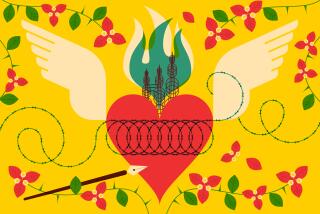Short History of Islam Is Useful Despite Its Flaws
Karen Armstrong, a respected and popular author of several books about religion, most recently “The Battle for God,” takes on a useful and formidable task in presenting the history of Islam in a single short volume. As many other such works have been written either by apologists or by those hostile to Islam Armstrong’s comprehensive and sympathetic work is welcome. She argues against those who identify Islam with its extreme militant manifestations, including Samuel Huntington in his “Clash of Civilizations,” and implicitly identifies more with Iranian President Mohammad Khatami’s continuing call for a “Dialogue of Civilizations.”
As might be anticipated in such a condensed and comprehensive work, Armstrong’s argument is uneven and sometimes suffers, especially in its consideration of the religion’s early sacred history, from confident assertions about events and ideas for which there is no consensus. She finds herself, however, on firmer footing when she writes about more recent periods, which are better documented.
Particularly strong is the last section, “Islam Agonistes,” which covers the period from the mid-18th century--when the West came in contact with Islam on a more regular basis--to the present. Armstrong notes that, sometime around 1600, Western society grew to be increasingly based upon technology and capital investment, a transformation that gave it a strength that other societies could not match. Later, when Muslim rulers tried to catch up, most often by directives from the top, most of the population was left behind, with a minority profiting from Westernization.
In addition, Western powers manipulated local economies and societies to benefit themselves, and, given the inequities between their interests and those of the host countries, it is not surprising that fundamentalist movements began to direct their passion against both secular rulers and their Western allies. Armstrong wisely shows, however, that the majority of fundamentalists are nonviolent and want to construct a more egalitarian society than the one introduced by the governments they opposed. This section, a section on key figures in the history of Islam, a glossary of Arabic terms and especially the excellent suggestions for further reading are highly recommended to general readers and students.
Less useful is her early history. The initial chronology is confusing and sometimes inaccurate and includes a number of strange statements. The chapter on Muhammad follows one line of interpretation, which nearly always puts original Islam in the best possible light for contemporary sensibilities; nowhere does Armstrong suggest that any other interpretation might be legitimate. She takes a controversial stand when she maintains that social justice and a fair distribution of wealth were “far more important than any doctrinal teaching about God.” Echoing apologists and some Islamic feminists, she says: “The emancipation of women was a project dear to the Prophet’s heart.” She is right that the Koran does not command veiling, but her examples of women’s Koranic rights to inheritance and divorce (not equal to men’s) are based on pre-Islamic practices rather than devotion to women’s emancipation. While the Koran considers both sexes equal as believers, it also contains passages endorsing male superiority. (She is right when she says that this trend became much stronger later.) Armstrong uses a translation of the Koran that is more in accord with liberal sensibilities than some other editions.
Armstrong focuses heavily on the non-Islamic character of the early rulers (caliphs) in her discussion of social justice and fails to consider other societal inequalities accepted in Islamic law and society. Women after the earliest period are ignored, as are the positions of slaves and non-Muslims. While non-Muslims were far better treated in Islamic societies than non-Christians were in the pre-modern West, they were never equal. Also, the role of nomadic tribes in Islamic societies is scarcely noted, and the contributions of Southeast Asia and sub-Saharan Africa are hardly mentioned, even though they often present alternatives to fundamentalism. And while most of what she says on Shiism is interesting, it is not error-free.
Armstrong gives too much space to the caliphs and too little to the development and provisions of Islamic law, which many consider the central feature of Islam. She stresses the sins of the caliphs and seems to prefer subsequent periods, when Sufi orders and other forms of piety became widespread. Many people prefer the early centuries of Islam, when rationalist philosophy and theology and free thought were more widespread than they are now.
While Armstrong’s history should not be taken as the last word, it is a well-written and interesting book that will help readers understand many aspects of one of the world’s fastest-growing religions.
Nikki Keddie is the author of “Roots of Revolution: An Interpretive History of Modern Iran” and co-editor of “Women in Middle Eastern History and Women in the Muslim World.”
More to Read
Sign up for our Book Club newsletter
Get the latest news, events and more from the Los Angeles Times Book Club, and help us get L.A. reading and talking.
You may occasionally receive promotional content from the Los Angeles Times.







